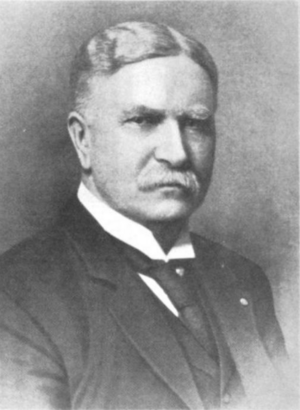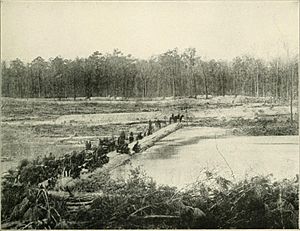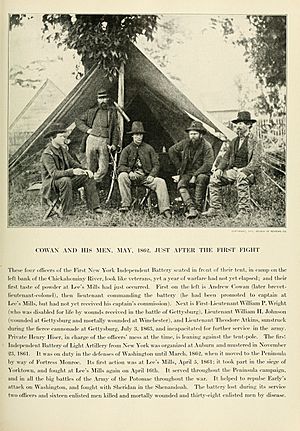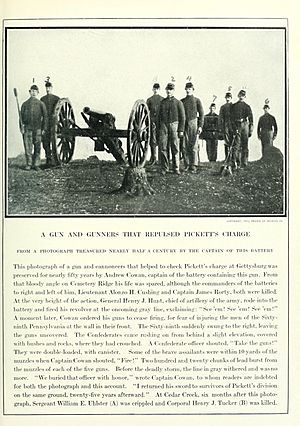Andrew Cowan (soldier) facts for kids
Quick facts for kids
Andrew Cowan
|
|
|---|---|
 |
|
| Born | September 29, 1841 Ayrshire, Scotland
|
| Died | August 23, 1919 (aged 77) Louisville, Kentucky
|
| Occupation | Soldier, businessman |
| Spouse(s) |
Mary Asdit
(m. 1864; died 1867)Anna L. Gilbert
(m. 1876) |
| Signature | |
Andrew Cowan (born September 29, 1841 – died August 23, 1919) was an important figure in American history. He was a soldier who fought for the Union (North) during the American Civil War. He was especially brave and skilled in battles like Gettysburg and Sayler's Creek. After the war, he became a very successful businessman. He used his wealth to help others through many good deeds. He also worked hard to bring the North and South back together after the war.
Contents
Andrew Cowan's Early Life
Andrew Cowan was born in Ayrshire, Scotland, on September 29, 1841. When he was a young boy, his family moved to the United States. He married his first wife, Mary Asdit, in New York State on February 23, 1864. They had a son named Albert Andrew Cowan in August 1867. Sadly, Mary died the next month, likely due to problems from childbirth.
Andrew Cowan's Civil War Service
Andrew Cowan had already served as a soldier in Virginia before becoming an officer. He joined an independent artillery unit.

Joining the 1st New York Battery
The 1st New York Battery was a group of soldiers recruited in Cayuga County. Andrew Cowan became the unit's first lieutenant. The battery joined the army as volunteers on November 23, 1861. They arrived in Washington, D.C. on December 4. The unit was officially named the 1st New York Battery a few days later.
Key Battles and Promotions
The 1st New York Battery was part of the Army of the Potomac. They fought in many important battles. These included the Peninsula Campaign, the Battle of Yorktown, and the Battle of Williamsburg. They also fought in the Seven Days Battles, the Battle of Antietam, and the Battle of Fredericksburg. During the Peninsula Campaign, Lieutenant Cowan was promoted to captain.
In the Chancellorsville Campaign, Cowan's battery helped cover the crossing of soldiers into Fredericksburg. They also supported troops at the Battle of Salem Church.
Heroism at Gettysburg
In May 1863, Cowan's battery was assigned to the Artillery Brigade of VI Corps. They played a crucial role in the Battle of Gettysburg. On July 3, 1863, the battery was placed near the "copse of trees" on Cemetery Ridge. This was just in time to face Pickett's Charge, a huge attack by Confederate soldiers.
Cowan's guns filled a dangerous gap in the Union line. He ordered his men to fire "double canister" at the attacking Confederates. This type of shot was like a giant shotgun blast. Their powerful fire stopped the Confederate threat. A newspaper even reported that Captain Cowan helped load and fire a gun himself during the intense fighting. A monument to the battery now stands at this historic spot.
Later Campaigns and Wounds
In late 1863, the battery fought in the Bristoe Campaign and the Mine Run Campaign. They continued to serve in the Overland Campaign and the early part of the Siege of Petersburg.
From October 1864, Cowan's battery joined the Union Army of the Shenandoah. During the Valley Campaigns of 1864, Cowan was wounded at the Third Battle of Winchester. His battery also saw very tough fighting at the Battle of Cedar Creek.
Commanding Artillery at Sailor's Creek
By early 1865, Captain Cowan was given the temporary rank of major. He took command of the entire Artillery Brigade of VI Corps. He led the VI Corps guns during the Appomattox Campaign.
At the Battle of Sailor's Creek on April 6, 1865, Cowan gathered 20 cannons near the Hillsman House. They opened fire, and the Confederates could not fire back because they had no cannons with them. Union soldiers attacked the Confederate rear guard. The Confederates pushed back the Union attack at first. However, Cowan's powerful cannons stopped the Southern advance. This allowed the Union infantry to regroup and counterattack. The Confederate line broke, and many were captured.
End of the War
Andrew Cowan was present when Confederate General Robert E. Lee surrendered. After the war ended, Cowan's battery returned home. They were officially discharged on June 23, 1865. The 1st New York Battery lost many soldiers during the war. Andrew Cowan left the army as a temporary lieutenant colonel.
Andrew Cowan's Life After the War
New Beginnings in Louisville
After the war, Andrew Cowan married his second wife, Anna Gilbert, in New York in 1876. They had a son, Gilbert S. Cowan, in Louisville, Kentucky. Andrew had moved to Louisville and became a successful leather merchant. At first, he wasn't very welcome in Louisville because he was from the North. But he eventually became a very important person in the city.
He served on company boards and even headed a printing company for the blind. He also helped raise money for the Statue of Liberty. In 1900, he visited the White House to talk about problems in Kentucky with President William McKinley.
Building Louisville's Parks
Many people think John Breckinridge Castleman created Louisville's park system. However, Andrew Cowan deserves much of the credit. He first suggested the idea of a park system in a newspaper article in 1887.
Cowan successfully pushed for the state law that created the Louisville Park Commission. He was also the one who first invited Frederick Law Olmsted, a famous landscape architect, to Louisville. Olmsted designed many famous parks, including Central Park in New York City. Cowan secretly helped Olmsted's company win the job to design Louisville's parks.
Helping Veterans and Healing the Nation
Cowan was very active in helping war veterans. On July 3, 1887, he played a big part in dedicating the monument to his battery at Gettysburg. He also gave a sword he found at Gettysburg to veterans of a Confederate division.
Cowan was good friends with Confederate survivors in Kentucky. They even made him an honorary member of their Orphan Brigade in 1912. He helped create the Gettysburg Peace Memorial Association, which aimed to bring former enemies together. He also proposed holding a Confederate reunion in Washington, D.C., in 1915. When the reunion happened in 1917, Cowan and President Woodrow Wilson were there. Cowan presented an American flag that was hung next to the Confederate banner. He also served as president of the Society of the Army of the Potomac, a group for Union veterans.
Andrew Cowan passed away in Louisville on August 23, 1919, at the age of 78.
Images for kids




